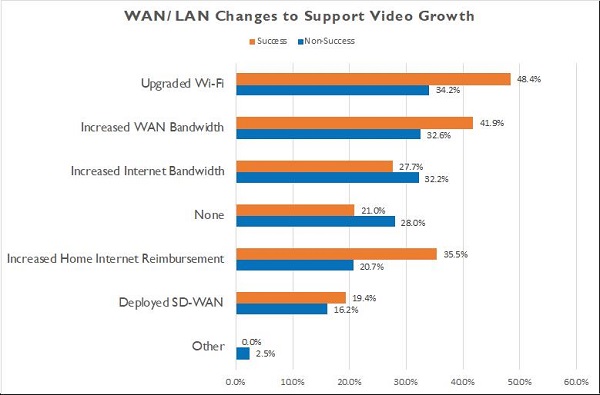IT and business leaders are slowly moving past the “panic” phase of the COVID-19-driven shift to remote work. However, according to Nemertes’ recently published “
Visual Communications and Collaboration: 2020-21” global research study of more than 525 organizations, the likelihood of companies simply returning to life as it was before the pandemic is small. Just 8.2% of participants expect to bring all employees back to their former workspaces. Nearly 36% expect WFH as it stands now to continue into the foreseeable future.
Those considering a return to the office must address three key areas: office layouts, networks, and policies to minimize the spread of COVID-19 and to ensure that workers are productive regardless of location.
Office Layouts
IT, facilities, HR, and business leaders have several factors to consider as they plan for the future of the physical office space:
- Crowded open offices are probably dead going forward. Companies are not going to assume the risk of having employees packed into open workspaces, sitting in desks across from and next to one another for long periods of time
- Meeting spaces will rapidly evolve; meeting room capacity will be reduced, and meeting rooms will likely be eliminated in favor of small working spaces for individuals
- Video conferencing will become ubiquitous; all meeting spaces, regardless of size, will require a conferencing system as the future of meetings will include a mix of in-person and remote participants, requiring video for effective collaboration
- Employees who do return to the office will require appropriate space for social distancing, or the ability to use enclosed office spaces such a huddle rooms or telephone-booth-style rooms
- HVAC systems must evolve to include high-quality filtering, frequent air exchanges, and potentially UV filtration systems to kill airborne viruses
Networks
Our study found that organizations, driven by massive increases in the use of video conferencing and streaming technologies, are increasing their investments in office networking. Targets include upgrading Wi-Fi, increasing WAN and Internet bandwidth, providing a higher stipend for remote worker network access, deploying SD-WAN or upgrading VPNs and implementing network optimization technologies. Those in our success group, defined as organizations with the highest ROI for their collaboration investments, are significantly more likely to be investing in network-related upgrades than those with lower, or no ROI.
The reality is that future meetings will leverage video conferencing. And, it’s likely that even those returning to the office will participate in meetings from isolated locations rather than return to the conference room, thus driving continued demand for high-quality video conferencing regardless of location.
Policies
Bringing employees back to the office will require close coordination among facilities, HR, and IT teams to minimize the potential spread of COVID-19 as well as to enable rapid reaction should an outbreak occur. Potential approaches include:
- Implementing mobile health screenings requiring employees to answer several questions each day prior to traveling to the office. A remote screening app should be integrated into building access systems to prevent those who have not completed the daily questionnaire from gaining building or office entry. Apps are increasingly available from stand-alone developers as well as health insurance organizations
- Requiring the use of contact tracing application, such as the system being developed by Apple and Google, that allows individuals to report their own infection, and receive notification if they have come into contact with other infected individuals, without sharing personally identifiable information
- Implementing space management applications such as New Wave Workspace to control office space density
- Leveraging capabilities from vendors including Cisco and others to schedule meeting room cleaning
- Allowing employees to take paid leave to deal with long-term infections, or to care for family members suffering from active infections, without being pressured to return to the office
- Leveraging collaboration tools like video conferencing and team apps to improve the ability of remote workers to communicate and collaborate
Safely returning to the office requires close coordination of facilities, HR, IT, and lines of business leaders. Ensure that your plan accounts for necessary changes to, and investments in, office layouts, networks, and appropriate technologies and policies to provide for a safe working environment.





